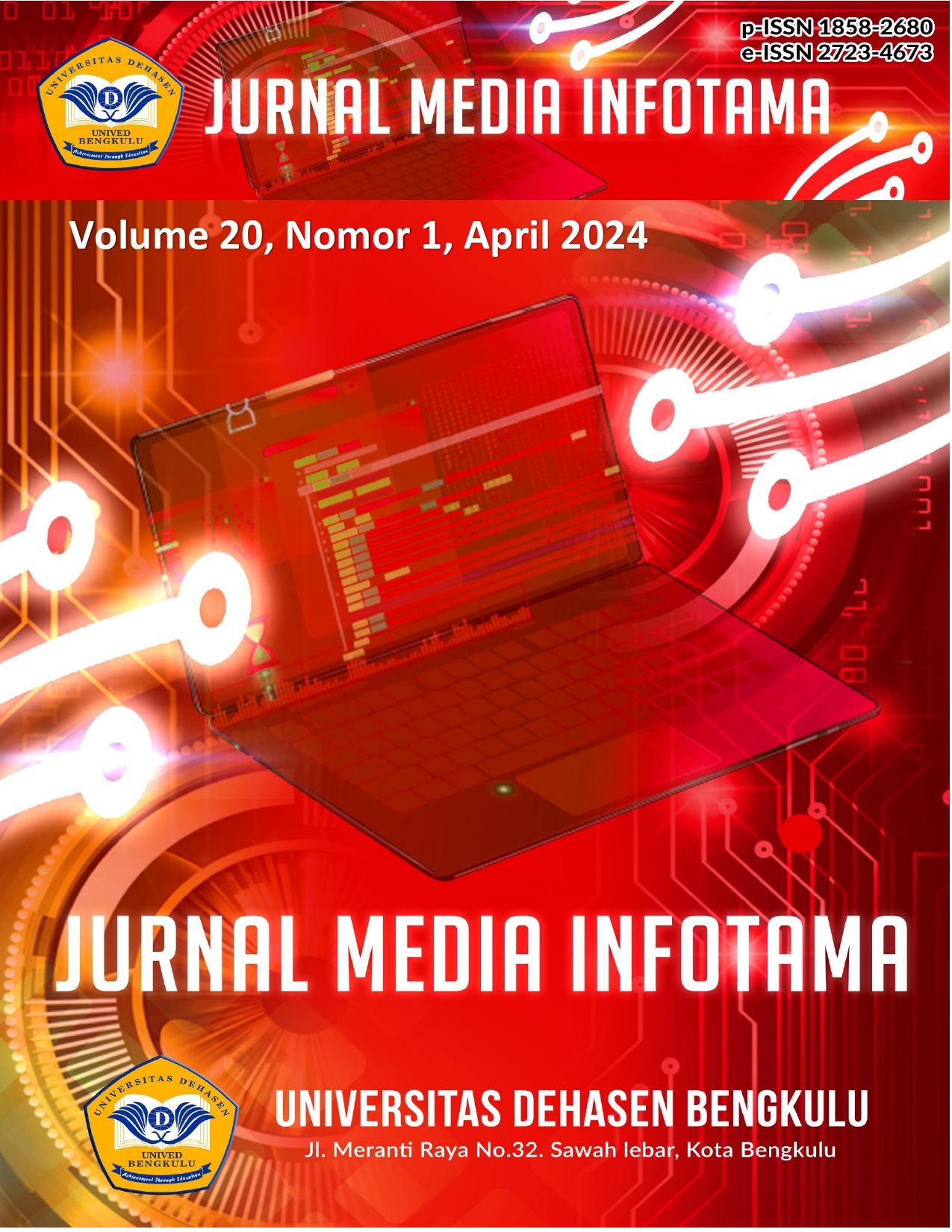Klasifikasi Tingkat Kematangan Buah Nanas Berdasarkan Fitur Warna Menggunakan Metode K–Nearest Neighbor (KNN)
Abstract
This study aims to determine the extent to which the KNN algorithm is able to classify pineapple fruit based on color features with high accuracy and determine the best k value in the KNN algorithm to achieve optimal accuracy in the classification of pineapple maturity levels. In the process of classifying pineapple fruit manually by using the human eye is a very difficult thing to do. This is evidenced by the inconsistency and subjective nature that causes a low level of accuracy. Therefore, to increase the level of accuracy and reduce the subjectivity of the human eye, this research proposes an algorithm that can be used to classify the maturity level of pineapple fruit, namely with K-Nearest Neighbor based on the color of the skin on the fruit. The k value used in this research is 1, 3, 5, 7, and 9 to test the Euclidean distance search on images with a size of 300x300 pixels. The research conducted proves that with Euclidean distance k = 5 and k = 9 has a percentage value of 73%. Based on the level of accuracy, color features k = 5 and k = 9 show the best k value on the classification of pineapple ripeness level.
Downloads
References
[2] Andono, P. N., Sutojo, T., & Muljono. (2017). Pengolahan Citra Digital. Yogyakarta: Andi
[3] Badan Pusat Statistika RI. (2019). Statistik Tanaman Buah-buahan dan Sayuran Tahunan Indonesia. Jakarta: Badan Pusat Statistika RI.
[4] Basuki, A., Palandi, J.F., & Fatchurrochman. (2005). Pengolahan citra digital menggunakan visual basic. Yogyakarta: Grada Ilmu.
[5] Basuki, Achmad. 2005. Metode Numerik dan Algoritma Komputasi. Yogyakarta: ANDI.
[6] Dalimartha, S. (2001). Atlas Tumbuhan Obat Indonesia Jilid 2 Nanas. Trubus Agriwidya.
[7] Firlansyah, Alfian, Andi Baso Kaswar, and Andi Akram Nur Risal. "Klasifikasi Tingkat Kematangan Buah Pepaya Berdasarkan Fitur Warna Menggunakan JST." Techno Xplore: Jurnal Ilmu Komputer dan Teknologi Informasi 6.2 (2021): 55-60.
[8] Hanafi, M. Habib, Nurul Fadillah, and Ahmad Insan. "Optimasi Algoritma K-Nearest Neighbor untuk Klasifikasi Tingkat Kematangan Buah Alpukat Berdasarkan Warna." IT Journal Research and Development 4.1 (2019): 10-18.
[9] Hermawati Astuti Fajar. 2013. Pengolahan Citra Digital;Konsep dan Teori. Penerbit Andi, Yogyakarta.
[10] Humaira, B., et al. "Klasifikasi Tingkat Kualitas dan Kematangan Buah Tomat Berdasarkan Fitur Warna Menggunakan Jaringan Syaraf Tiruan." Journal of Embedded Systems, Security and Intelligent Systems 2.1: 20-26.
[11] Irfandi. (2005). Karakterisasi morfologi lima populasi nanas (Ananas comosus (L.) Merr). Program Studi Hortikultura Fakultas Pertanian Institut Pertanian Bogor.
[12] Kadir, A. dan Adhi, S. (2012), Teori dan Aplikasi Pengolahan Citra, Yogyakarta: ANDI Yogyakarta.
[13] Kusuma, S. F., Pawening, R. E., & Dijaya, R. (2017). Otomatisasi klasifikasi kematangan buah mengkudu berdasarkan warna dan tekstur. Register: Jurnal Ilmiah Teknologi Sistem Informasi, 3(1), 17-23.
[14] B Lubis, E. R. 2020. Budidaya nanas. Bhuana ilmu Populer. Jakarta.
[15] Lustini, Apriyanti. "Klasifikasi Tingkat Kematangan Buah Nanas Menggunakan Ruang Warna Red–Green–Blue Dan Hue–Saturation–Intensity." Jurnal Digital Teknologi Informasi 2.1 (2019): 1-8.
[16] Maulana, S. (2021). Klasifikasi Kualitas Buah Pir Berdasarkan Warna Dan Tekstur Dengan Menggunakan Metode K-Nearest Neighbor (Knn) (Doctoral dissertation, Universitas Islam Lamongan).
[17] Memahami Arti Klasifikasi Menurut Kamus dan Para Ahli, Ketahui Juga Contoh Penerapannya. (2022). Diakses pada 08 Desember 2022 dari https://plus.kapanlagi.com/memahami-arti-klasifikasi-6c29e5.html
[18] H Mubarok, Hasan, Sylviana Murni, and Mayanda Mega Santoni. "Penerapan Algoritma K-Nearest Neighbor Untuk Klasifikasi Tingkat Kematangan Buah Tomat Berdasarkan Fitur Warna." Prosiding Seminar Nasional Mahasiswa Bidang Ilmu Komputer dan Aplikasinya. Vol. 2. No. 1. 2021.
[19] Mubarok, Hasan, Sylviana Murni, and Mayanda Mega Santoni. "Penerapan Algoritma K-Nearest Neighbor Untuk Klasifikasi Tingkat Kematangan Buah Tomat Berdasarkan Fitur Warna." Prosiding Seminar Nasional Mahasiswa Bidang Ilmu Komputer dan Aplikasinya. Vol. 2. No. 1. 2021.
[20] H Muhammad, Duwen Imantata, Ermatita Ermatita, and Noor Falih. "Penggunaan K-Nearest Neighbor (KNN) untuk Mengklasifikasi Citra Belimbing Berdasarkan Fitur Warna." Informatik: Jurnal Ilmu Komputer 17.1 (2021): 9-16.
[21] Munir, R. 2004. Pengolahan citra digital dengan pendekatan algoritmatik. Penerbit Informatika, Bandung.
[22] Oktaviani, D. (2009). Pengaruh Media Tanam Dan Asal Bahan Stek Terhadap Keberhasilan Stek Basal Daun Mahkota Nanas (Ananas comosus (L.) Merr.) (Skripsi). Fakultas Pertanian.
[23] Prasetyo, Nevalen Aginda, et al. "Sistem Identifikasi Tingkat Kematangan Buah Nanas Secara Non-Destruktif Berbasis Computer Vision." Journal of Energy, Material, and Instrumentation Technology 2.1 (2021): 1-10.
[24] Purba, Yanri Bili Eliezer, et al. "Perancangan Alat Pendeteksi Kematangan Buah Nanas Dengan Menggunakan Mikrokontroler Dengan Metode Convolutional Neural Network (CNN)." Jurnal Ilmiah Teknik Informatika METHOTIKA 2.1 (2022): 13-21.
[25] Putra, D. 2010. Pengolahan citra digital. Penerbit ANDI, Yogyakarta.
[26] Razka, Muhammad Hanif, et al. "Klasifikasi Tingkat Kematangan Buah Apel Berdasarkan Fitur Warna Menggunakan Algoritma K-Nearest Neighbor dan Ekstraksi Warna HSV." Prosiding Seminar Nasional Mahasiswa Bidang Ilmu Komputer dan Aplikasinya. Vol. 2. No. 2. 2021.
[27] Riadi, Muchlisin. (2016). Pengolahan Citra Digital. Diakses pada 2023, dari https://www.kajianpustaka.com/2016/04/pengolahan-citra-digital.html
[28] Siswanto, Irwan, Ema Utami, and Suwanto Raharjo. "Klasifikasi Tingkat Kematangan Buah Berdasarkan Warna dan Tekstur Menggunakan Metode K-Nearest Neighbor dan Nearest Mena Classifier." Inspiration: Jurnal Teknologi Informasi dan Komunikasi 10.1 (2020): 93-101..
[29] Sugiyono. (2018). Metode Penelitian Kuantitatif, Kualitatif, dan R&D. Bandung: Alfabeta..
[30] Sugiyono. 2016. Metode penelitian pendidikan pendekatan kuantitatif dan kualitatif dan R&D. Bandung : Alfabeta.
[31] Suprianto, C. (2016). Grow your own fruits- panduan praktis menanam 28 tanaman buah populer di perkarangan. Yogyakarta: Lily Publisher, Penerbit Andi.
[32] Sutoyo, T., et al. "Wijanarto." Teori Pengolahan Citra Digital, Penerbit Andi, Yogyakarta (2009): 256.
[33] P Syarifah, A., Riadi, A. A., & Susanto, A. (2022). Klasifikasi Tingkat Kematangan Jambu Bol Berbasis Pengolahan Citra Digital Menggunakan Metode K-Nearest Neighbor. JIMP (Jurnal Informatika Merdeka Pasuruan), 7(1).
[34] Wijaya, N., & Ridwan, A. (2019). Klasifikasi Jenis Buah Apel Dengan Metode K-Nearest Neighbors Dengan Ekstraksi Fitur HSV dan LBP. Jurnal Sisfokom (Sistem Informasi dan Komputer), 8(1), 74-78.
[35] Yanosma, Delfi, Asahar Johar, and Kurnia Anggriani. "Implementasi Metode K-Nearest Neighbor (KNN) dan Simple Addittive Weighting (SAW) dalam Pengambilan Keputusan Seleksi Anggota PASKIBRAKA." Rekursif: Jurnal Informatika 4.2 (2016).
[36] Yanti, Putri, Wayan. “Deteksi Kematangan Buah Nanas Berdasarkan Tingkat Kekuningan Mata Nanas Dengan Menggunakan Metode Tresholding.” (2022): 31.
[37] Zonyfar, C. (2020). Pengolahan Citra Digital. Banten: Desanta Muliavisitama.
Copyright (c) 2024 Yuza Reswan, Rozali Toyib, Harry Witriyono; Ani Anggraini

This work is licensed under a Creative Commons Attribution-ShareAlike 4.0 International License.
An author who publishes in Jurnal Media Infotama agrees to the following terms:The author holds the copyright and grants the journal the right of first publication of the work simultaneously licensed under the Creative Commons Attribution-Share Alike 4.0 License which allows others to share the work with acknowledgment of the work's authorship and initial publication in this journal.Submission of a manuscript implies that the submitted work has not been previously published (except as part of a thesis or report, or abstract); that it is not being considered for publication elsewhere; that its publication has been approved by all co-authors. If and when a manuscript is accepted for publication, the author retains the copyright and retains the publishing rights without limitation.
For new inventions, authors are advised to administer the patent before publication. The license type is CC-BY-SA 4.0.
MEDIA INFORMATION REVIEW: Journal of the Faculty of Computer Science is licensed under a Creative Commons Attribution-ShareAlike 4.0 International License.You are free to:Share
— copy and redistribute material in any medium or formatAdapt
— remix, modify and develop materialfor any purpose, even commercial.
The licensor cannot revoke this freedom as long as you follow the license terms












.png)


